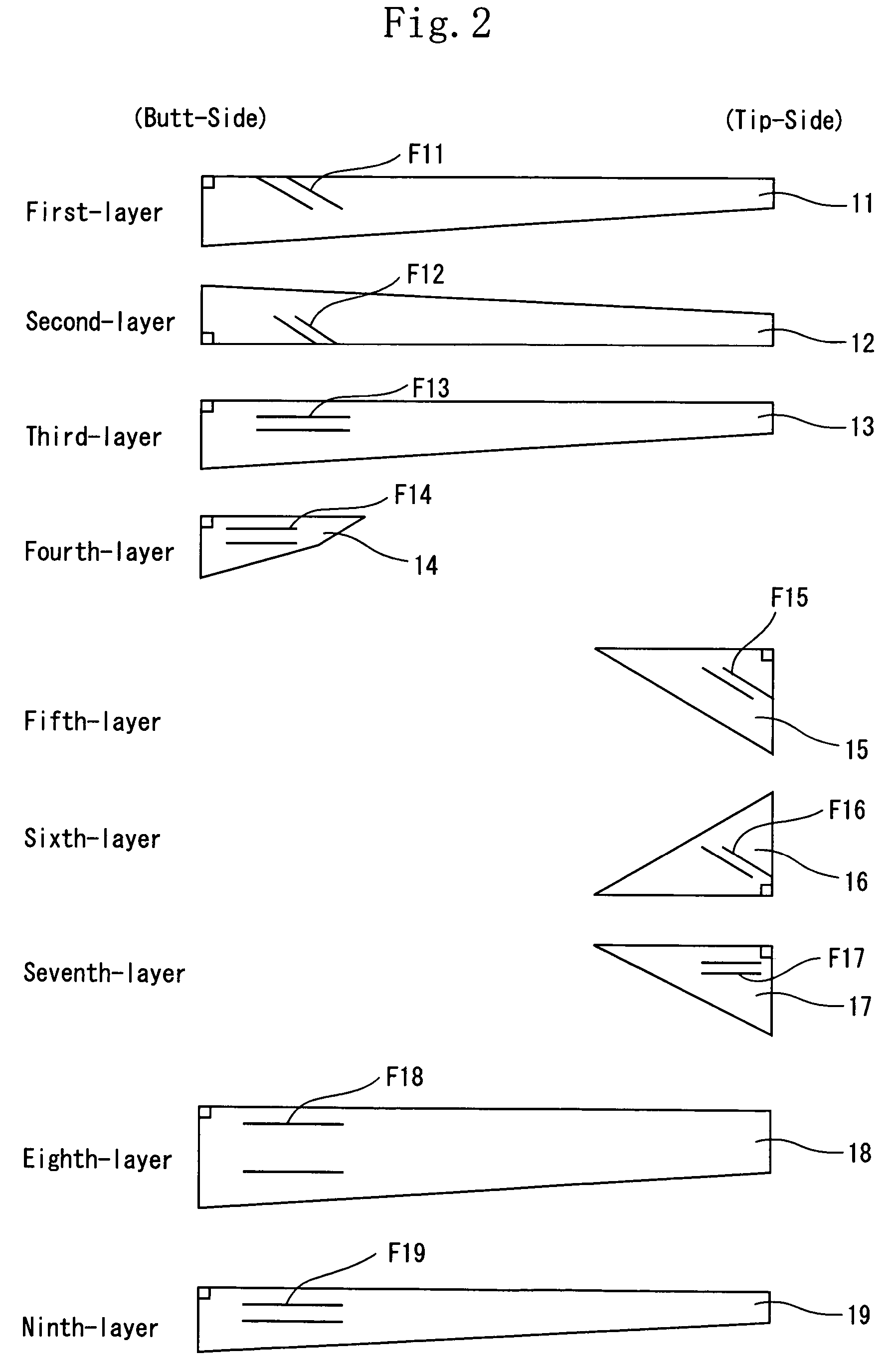Golf club shaft
a golf club and shaft technology, applied in the field of golf club shafts, can solve the problems of insufficient flexural flexural force of shafts, large ei of flexural rigidity, etc., and achieve the effect of high trajectory and high strength
- Summary
- Abstract
- Description
- Claims
- Application Information
AI Technical Summary
Benefits of technology
Problems solved by technology
Method used
Image
Examples
example 1
[0061]The shaft of the example 1 was similar to that of the first embodiment in its construction. More specifically, the tip-side reinforcing layer was formed in the range from the tip of the shaft to the position located at 20% of the distance from the tip to the butt. The fifth-layer and sixth-layer prepregs were formed as the tip-side reinforcing angular layers. The reinforcing fiber of the fifth-layer prepreg and that of the sixth-layer prepreg had an orientation angle of −45 and +45° respectively. The reinforcing fiber of each of the fifth-layer prepreg and the sixth-layer prepreg had a tensile modulus of elasticity of 24 ton / mm2. The seventh-layer prepreg was formed as the tip-side reinforcing straight layer. The reinforcing fiber of the seventh-layer prepreg had a tensile modulus of elasticity of 10 ton / mm2. The ratio of the weight of the tip-side reinforcing straight layer to that of the tip-side reinforcing angular layer was set to 0.7. The diameter of the tip of the shaft ...
example 2
[0063]The tip-side reinforcing layer was formed in the range from the tip of the shaft to the position located at 25% of the distance from the tip to the butt. The fifth-layer and sixth-layer prepregs were formed as the tip-side reinforcing angular layers. The reinforcing fiber of the fifth-layer prepreg and that of the sixth-layer prepreg had an orientation angle of −60° and +60° respectively. The reinforcing fiber of each of the fifth-layer prepreg and the sixth-layer prepreg had a tensile modulus of elasticity of 30 ton / mm2. The seventh-layer prepreg was formed as the tip-side reinforcing straight layer. The reinforcing fiber of the seventh-layer prepreg had a tensile modulus of elasticity of 15 ton / mm2. The ratio of the weight of the tip-side reinforcing straight layer to that of the tip-side reinforcing angular layer was set to 0.75. The diameter of the tip of the shaft was set to 9.5 mm. The length of the shaft was set to 991 mm. The minimum value of the flexural rigidity (EI)...
example 3
[0065]The tip-side reinforcing layer was formed in the range from the tip of the shaft to the position located 15% of the distance from the tip to the butt. The fifth-layer and sixth-layer prepregs were formed as the tip-side reinforcing angular layers. The reinforcing fiber of the fifth-layer prepreg and that of the sixth-layer prepreg had an orientation angle of −20° and +20° respectively. The reinforcing fiber of each of the fifth-layer prepreg and the sixth-layer prepreg had a tensile modulus of elasticity of 30 ton / mm2. The seventh-layer prepreg was formed as the tip-side reinforcing straight layer. The reinforcing fiber of the seventh-layer prepreg had a tensile modulus of elasticity of 5 ton / mm2. The ratio of the weight of the tip-side reinforcing straight layer to that of the tip-side reinforcing angular layer was set to 0.80. The diameter of the tip of the shaft was set to 10.0 mm. The length of the shaft was set to 991 mm. The minimum value of the flexural rigidity (EI) in...
PUM
 Login to View More
Login to View More Abstract
Description
Claims
Application Information
 Login to View More
Login to View More - R&D
- Intellectual Property
- Life Sciences
- Materials
- Tech Scout
- Unparalleled Data Quality
- Higher Quality Content
- 60% Fewer Hallucinations
Browse by: Latest US Patents, China's latest patents, Technical Efficacy Thesaurus, Application Domain, Technology Topic, Popular Technical Reports.
© 2025 PatSnap. All rights reserved.Legal|Privacy policy|Modern Slavery Act Transparency Statement|Sitemap|About US| Contact US: help@patsnap.com



